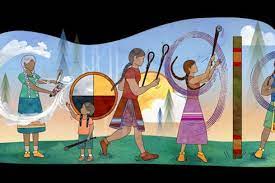Google Doodle celebrates indigenous North American stickball
Today, Google is celebrating indigenous North American stickball with its iconic doodle. The game has been played by several Native American nations for centuries as a way to display courage and physical strength. Stickball served a variety of functions including settling disputes, providing recreation, teaching discipline, and more. It is believed that the game could also have helped hone skillful diplomacy in times of war and peacemaking among tribal nations. Today’s doodle honors this long-standing tradition comprising elements such as combat challenges, one-on-one contests, and even feats of oratory prowess — from players all around the world!
Introduce the Stickball game and its origin
Stickball is a Native American game that has been played for centuries. Its origins can be traced back to tribes in the Northeastern United States, who used it as a way to settle disputes and build camaraderie among members of the community. The game involves hitting a small ball with a long stick and requires agility, speed, and strategy. While different tribes may have their variations, the basic principles remain the same. Today, Stickball has evolved into a cultural tradition that is still played in Native American communities across the country. It serves as a way to honor the past, connect with the present, and inspire future generations to preserve this important piece of their heritage.
Discuss the importance of Stickball in North American Indigenous culture
Stickball has been a significant part of North American Indigenous culture for centuries. This traditional sport holds immense cultural, spiritual, and social value to Indigenous communities. It is not just a game but a way of life that brings people together strengthens relationships, and preserves Indigenous heritage. Stickball is often used in ceremonies and rituals to celebrate important events, such as the changing of seasons or the harvest, and as a means of resolving conflicts or settling disputes.
The playing of stickball is a display of bravery, skill, and sportsmanship, and the game teaches young people the importance of teamwork, discipline, and perseverance. Beyond its historical significance, stickball has also become a way to preserve the language, music, and arts of Indigenous culture. As such, it holds a special place in the hearts and minds of Indigenous peoples and continues to be an enduring symbol of their identity and resilience.
Describe how the Doodle celebrates the game and its significance
The Doodle is a colorful and animated tribute to the game, showcasing its rich history and enduring impact on culture. It captures the essence of the game with whimsical illustrations and playful animations that depict the excitement and energy of this beloved pastime. The significance of the game is evident in the attention to detail that went into creating this delightful Doodle, which pays homage to everything from the iconic diamond-shaped field to the passionate fans who cheer on their favorite teams. Whether you’re a die-hard fan or simply appreciate the game’s cultural significance, this charming tribute is sure to delight and entertain.
Explain why Google chose the stickball game to honor their doodle
Google recently featured an interactive doodle that celebrated the traditional Native American game of stickball. The popular search engine’s decision to honor this sport highlights the cultural significance of stickball for Native Americans. This game, known as the “Little Brother of War,” was traditionally played by various tribes across North America to settle disputes and build alliances. Two teams would face off with sticks, attempting to carry a ball to their opponent’s goalpost. This fast-paced and physically demanding game required skill, strategy, and teamwork. Google’s commemoration of stickball is an important recognition of the rich history and culture of Native American people.
Showcase examples of Stickball doodles from around the world
Stickball is a beloved game that has been played all around the world for centuries. One of the unique ways that fans celebrate this ancient game is by creating Stickball doodles. These doodles are creative expressions of Stickball imagery that capture the essence of this timeless sport. From the scorching deserts of Africa to the busy streets of New York City, Stickball fans have been sharing their doodles for generations.
These doodles are a testament to the universal appeal of Stickball, and they offer a glimpse into the cultural influences that have shaped this beloved game. Whether you’re a lifelong fan or a curious newcomer, Stickball doodles are a fascinating way to explore the world of Stickball and its impact on global culture.
Invite readers to participate in a discussion about indigenous cultures and games such as Stickball
Indigenous cultures have a rich history of traditional games, and Stickball is one of the most popular and oldest of these games. Played by tribes across North America, it involves two teams who use wooden sticks to move a ball across a field and score goals. Not only is the game an exciting and physically challenging activity, but it also holds deep cultural significance for Indigenous communities.
Through Stickball, players develop teamwork, discipline, and sportsmanship while carrying on important traditions. Let’s explore the importance of Stickball and other traditional games in Indigenous cultures and discuss their impact on communities both past and present.
Stickball, a traditional Indigenous North American sport, is an important part of our history and culture. Google’s doodles celebrating the game serve to honor it and recognize its impact on this continent’s heritage. The various stickball doodles created around the world also showcase how stickball has been welcomed by different cultures, fostering inclusivity and understanding.
In taking these steps to pay tribute to the game and its many incantations amongst people from all backgrounds, we can use these stories as a way to centralize dialogue about the significance of indigenous cultures and their different ways of life. Even though many indigenous people have passed down stories throughout generations, what we can all do with access to technology is coordinate conversations across borders and share collective experiences surrounding games such as stickball.







